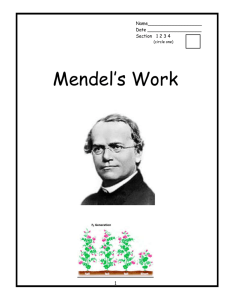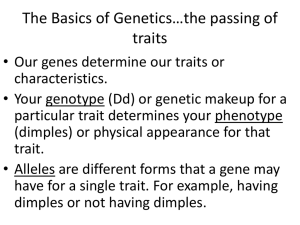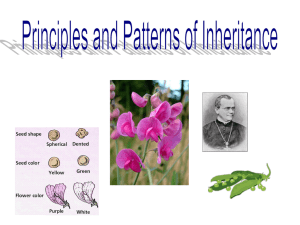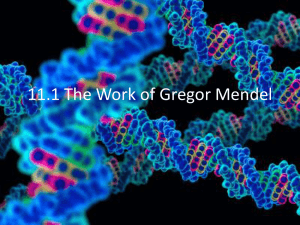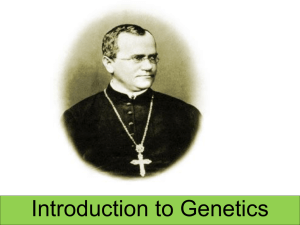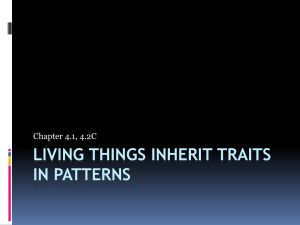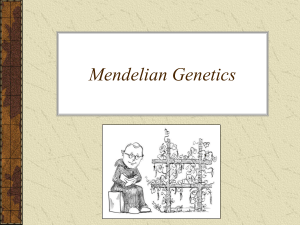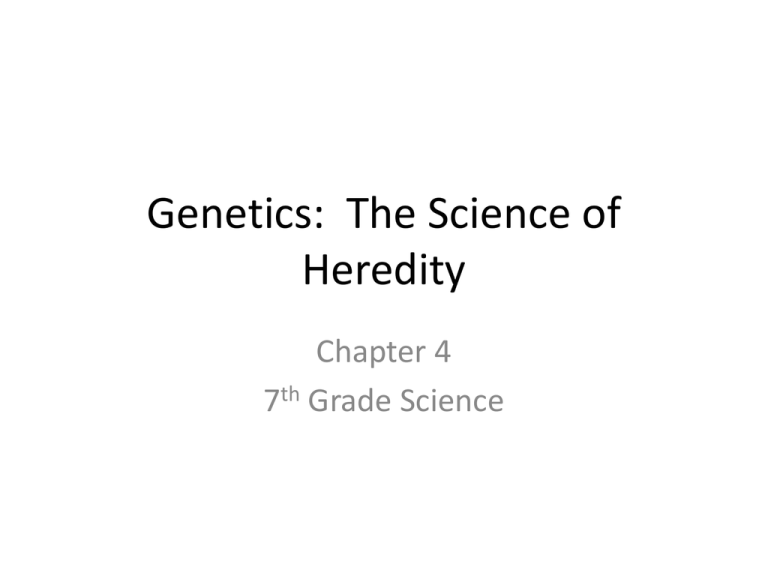
Genetics: The Science of
Heredity
Chapter 4
7th Grade Science
Mendel’s Work
Gregor Mendel
• ______________
- “Father of Genetics”
– A priest that conducted experiments in his garden
that revolutionized the study of heredity.
– ___________
- the passing of physical
Heredity
characteristics from parents to offspring
– Mendel used pea plants to observe _________
of
traits
pea plants.
traits
– _________
- a characteristic that an organism can
pass on to its offspring through its genes.
Mendel and Heredity
• Mendel experimented with hundreds of pea
plants to understand the process of ________.
heredity
• ________
- the scientific study of heredity.
Genetics
• Mendel “crossed” pea plants with contrasting
traits
________
and observed the outcomes of
traits in the offspring.
• Mendel started his experiments with
________
purebred pea plants or plants that have had
the same trait for many generations.
Crossing Pea Plants
Purebred
• __________
short pea plants come always
come from short parent plants.
Mendel’s Experiments
Generations and Offspring
• _____________
- parent generation
P generation
• _________________
First “filial” generation - the offspring from the first
parent generation. “Filia” comes from the Latin
word meaning son or daughter. This generation
is noted as __
f₁ - all of the plants in this generation
were tall.
• _________
F₂ generation - Mendel allowed the plants in the f₁
generation to self pollinate. The plants in the f₂
generation - the result was a mix of short and tall
plants
Mendel’s Conclusion
• Mendel’s Conclusions included:
genetic
– Individual factors or sets of _________
information controls the __________
inheritance of traits in
peas.
pairs - one
• The factors that control each trait exist in _____
female parent and one from the
from the _______
_______parent.
male
• One factor in each pair can mask or hide the other
factor.
Dominant and Recessive
• ________factors that control a trait.
Gene
• _____
Alleles - different forms of the gene
• Offspring inherit one _______
from each parent –
Allele
one could be tall and the other could be short,
both could be tall, both could be short – it
genetic
depends on the ________
information from the
parent.
• ____________
Dominant allele - the trait that always shows up in
the organism when the allele is present
• ____________
Recessive Allele - hidden whenever the dominant
allele is present
Genetics of Pea Plants
Alleles in Mendel’s Crosses
short
• Purebred
___________
- only pea plants that inherit
two recessive alleles for short stems will be
short.
• _________
- organism has two different alleles
hybrid
for a trait.
• ________
alleles.
Dominant alleles mask the ________
recessive
• A dominant allele is represented by a capital
______
letter. Recessive alleles are represented by
Lower case letters.
________
Pea Plant traits
Probability and Heredity
probability - a number that describes how
• ________
likely it is that an event will occur. Not
necessarily what will occur.
• Example: coin toss – the more tosses you
make, the closer the actual results will be to
the results predicted by probability.
• Each toss yields a result that is __________
of
independent
all other tosses.
Probability and Genetics
• Mendel was the first scientist to recognize
probability
that the principles of __________
can be used
Genetic crosses
to predict the results of ___________.
Punnett Square - a chart that shows all the
• ____________
possible combinations of ________
that can
alleles
result from a genetic cross.
• The boxes in the Punnett Square represent the
possible alleles that the offspring can
inherit
_______.
Punnett Square Examples
Phenotypes and Genotypes
phenotype
• ____________
- an organisms physical
appearance or visible traits.
genotype
• ___________
- an organisms genetic makeup,
or allele combinations.
• ___________
- two identical alleles for a trait
homozygous
heterozygous - two different alleles for a trait
• ___________
• Mendel used the term _________
to describe
hybrid
heterozygous
__________ pea plants.
Codominance
Codominance - the alleles are neither dominant
• __________
nor recessive – both alleles are expressed in
the offspring.
Chromosomes and Inheritance
• _______________________
Chromosome Theory of inheritance- genes are carried
from parents to their offspring on chromosomes.
• _______
meiosis - the process by which the number of
chromosomes is reduced by half to form sex cells
Sperm and egg
– ____________.
– Chromosome pairs separate and are distributed to
two different cells.
– The resulting sex cells have only half as many
chromosomes as the other cells in the organism.
Meiosis
Meiosis and Punnett Square
Punnett Square
• _____________-show
the events that occur in
meiosis.
Chromosome pairs separate and go into
– When the _______________
Sex cells so do the _________
allele
two different ________,
carried on each chromosome.
– Punnett Squares show the possible allele
fertilization
combinations after __________.
Punnet Square
Genes
23
• The body cells of humans contain ____
chromosome pairs.
genes
• Chromosomes are made up of many ______
joined together like beads on a string.
• Body cells contain between _______________
20,000-25,000 genes
gene
trait
• Each ______
controls a _____
• The _______
are lined up in the same order
genes
chromosome
on each ___________.
Chromosomes and Genes
The DNA Connection
• _______
- control the production of ________
gene
proteins
in an organisms cells.
• __________
- determine the size, shape, color
proteins
and many other traits of an organisms.
• A gene is a section of DNA
_______ molecule that
contains the information to code for a specific
__________.
protein
• Each _______
is located in a place on a
gene
_________
chromosome
Order of Bases
• _________contains
the code
_____ that
gene
determines the structure of the ______.
protein
• ___________
that
Nitrogen Bases form a ___________
Genetic code
protein will be
specifies what type of ______
produced.
• _________
- long chains molecules of
proteins
individual __________.
Amino acids
• A group of _____________
codes for one
3 DNA bases
Amino acid
specific __________.
How cells make proteins
• Protein
___________
Synthesis - production of proteins – cells
use the information from a gene on a
protein
chromosome to produce a specific _______.
ribosome
• Protein synthesis takes place on the ________
in the __________
of the cell.
cytoplasm
• ____
RNA - ribonucleuc acid – “Messenger” carries
the genetic code from the DNA inside of the
nucleus to the ________.
cytoplasm
DNA / RNA
2 strands
1 strand
• DNA has ________,
RNA has _________
• Both DNA and RNA contain ___________
Sugar molecules but
they are different
A, T, C, G
• DNA has four bases - ___________
A, C, G and uracil
• RNA has ____________
Messenger RNA and
• 2 types of RNA - ____________
____________
Transfer RNA
RNA
Messenger RNA - copies the coded message
• ____________
from the DNA in the nucleus and carries the
message to the ribosome in the cytoplasm.
• ____________
- carries amino acids to the
Transfer RNA
ribosomes and adds them to the growing
protein
Translating the Code
• 1. Message transferred to the messenger RNA
• 2. Messenger RNA attaches to the Ribosome
• 3. Transfer RNA attaches to the Messenger
RNA
• 4. Protein Production continues.
• www.brainpop.com
• Page 134-135
Mutations
• _________
- any change in a gene or
Mutation
chromosome.
• Mutations can cause a cell to produce an
Protein synthesis - this
incorrect protein during ____________
change can effect the organisms trait or
phenotype.
• Mutations that occur in sex cells can be
passed on to _______.
Other mutations are
offspring
not passed on.

